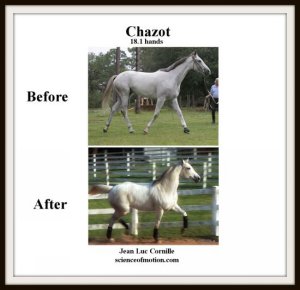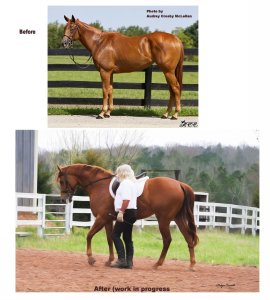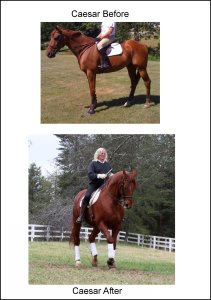Chazot THoughts 45
Chazot Thoughts
45



“Any intelligent fool can make things bigger, more complex, and more violent. It takes a touch of genius - and a lot of courage - to move in the opposite direction.” (Albert Einstein)
Charpege did not realize that I was looking at her while Caesar passed in the corridor between her stall and my stall. She looked at his base of the neck, his back, his butt. Caesar halted between the cross ties, and she was still looking at his butt when she realizes that I was looking at her, quite amused. She blushed a little, realizing that I surprised her, staring at a guy butt. ”It is not what you think. I was looking at his muscular development. You guys, you are just enormous. I never see horses that much developed muscularly.”
“I noticed your muscular development on the day of my arrival. It was Tom in the next stall. First, I thought that he is a Fresian, but I looked at you; you are a thoroughbred like me. Caesar is a Selle Français, and Manchester is an Hannoverian. The feeding program gives us all the nutrients that we need, but I tested Manchester neck with my nose, and your back, and Caesar butt, and it is all muscles; you feel hard like a rock. Then, I watched your work. I was expecting a lot of commotion, fast moves, intense accelerations, and, on the contrary, it is all rhythmic, quiet, slow, harmonic. It looks like ballet, and you develop like bodybuilders. What is the secret?”
Caesar responded, “The secret is that he works our muscles the way our muscles are designed to work. Muscles do not need stretching and release or relaxation. They need coordination. They need to work within their range of motion. They will warm up as they are not aggressed by contractions or elongations that are out of their normal range of motion as well as their proper frequency. He knows that contractile cells and connective tissues have to be tuned at our stride frequency inside our muscles, and he never rush us faster than our natural cadence. He knows that inside our muscles, our connective tissues are indeed tendinous components. This is why he does not move much. He understands that if he was moving his vertebral column in a relaxed and loose fashion. He would induce an excessive reaction of our muscles' tendinous elements, forcing our muscle cells to resist these vibrations instead of producing greater movement. Charpege eyes were all round, and big asking Caesar, “Are you speaking French?” I responded. This is precisely the type of comment that peoples who do not want to understand are making in response to his studies—those who do not want to know like it simple. The truth is that it is not simple, but it is relatively easy to comprehend, especially for us, as we are doing and feeling the work. Indeed for us, it is the difference between hell and heaven.
Caesar knows what he is talking about. He was on death row as a result of these stretching and fast forward theories. He and Helyn decided to save him and rehabilitate him two days before he was scheduled to be put to sleep. He had no muscles when he arrived. Let me explain to you why he does not stretch and release and relax. The reason is simple, and you will fully understand when you will understand how your body effectively works. Think about the long tendons of your lower leg. When you walk, trot, or canter, your hoof contact the ground, and your body weight, multiplied by the speed, creates what is called impact forces. Your fetlock translates downward during the first half of the stride, elongating your tendons. Your muscles to which you deep digital flexor and superficial flexor tendons are attached resist, optimizing the elastic strain energy stored in your tendons by creating appropriated resistance. Doing so, your tendons store, during the first half of the stride, the elastic strain energy that lifts your fetlock and propels your front limb into the swing phase. This is why the ones who believe that they can improve our range of motion by releasing our muscle tone before work have a poor understanding of our fundamental locomotion principle. At impact, for instance, our lower legs tendons are submitted to vibration than can exceed our tendons' integrity. Without proper tension of the muscle dampening the tendons, our tendons are exposed to damages. The tone and tension of our deep digital and superficial muscles are necessary.
There is a problem at the other end of the spectrum if our muscles spasm or tie-up. This is where therapies can be useful. Our deep digital flexor tendon, for instance, is less elastic than our superficial flexor. Our deep digital flexor muscles' fibers are longer than the ones of our superficial flexor muscles, allowing a greater range of adjustment. If we are asked an effort at the limit of elasticity of our tendon and our muscle is no longer giving, we are likely to damage our tendon. This type of hyper contraction or tie-up results from an imbalance between input and output of lactic acid in our muscles. This can occur as a result of fatigue or intense work. Unless significant calcium or other chemical imbalance, it does not happen at rest.
Now that you understand how long tendons and their correspondent muscles effectively work, we can go further and explore a situation where the tendon is inside the muscle belly. Higher in your front leg, at the level of your arm and forearm, you have a tendon in the middle of your biceps that is moving your arm and forearm forward into the swing phase. The work of the internal tendon of your biceps brachii is referred to as the “catapult mechanism.” The forward swing of your front limb is a quick movement that has to be done by the biceps' internal tendon because the contraction of the muscle cells is too slow.
As you can see, the relationship between muscles and tendons is not limited to the stereotype of short muscles and long tendons. Higher in your front leg, another system involving muscle cells and tendinous components is a great part of our capacity to spring the gaits. The muscles supporting our trunk between our forelegs are named serratus ventralis thoracic. They are constructed with two sheets of elastic tissue acting like tendons. These sheets of elastic tissues are called aponeurosis. The fibers of our serratus muscles are very short, only 50mm. Most of the movements are created by elastic recoil of the aponeurosis, in which tension is optimized by the fibers of our serratus muscles. All these examples explain the concept of elastic strain energy. A significant part of our locomotion is the result or storage and reuse of elastic strain energy. This is true for the hind legs as well. For instance, we have a thigh muscle named Tensor Fascia Latae, and it is built with aponeurosis like our serratus muscles. During the time our supporting and propulsive hind leg is on the ground, our tensor fascia lata muscle's aponeurosis is storing elastic strain energy that is reused for the swing of our hind leg forward. This whole system allows us to be fast and run for a long time as it is energetically much more efficient having muscles optimizing the elastic recoils of tendons or aponeurosis, which are moving our legs than if it was our muscles that would directly move our limbs. “The elastic energy stored in and recovered from tendons during cyclical locomotion can reduce the metabolic cost of locomotion.” (Cavagna et al., 1977; Alexander, 1988; Roberts et al., 1997).
The concept of storage and reuse of elastic strain energy in our tendons and aponeurosis is the fundamental principle of our locomotion. Do you want me to explain it again, or are you OK with the next step? Charpege responded a little annoyed, “I am not a keyboard rider; I can understand a complex concept as long as it is clearly explained.” I thought that I have an easier job than him.
Now we can explore a principle a little more complex. Imagine that our muscles are constructed with cells, which contract and tendinous components that vibrate. The principle of elastic strain energy, which happens between our muscles and our lower legs long tendon, does occur at a lesser level within our muscles belly. Our muscles are composed of cells that contract and connective tissues that are tendinous components. Therefore, our muscles can store and reuse elastic strain energy even in the absence of tendons. I remember the quote from one of his studies. “The muscle itself stores and recovers elastic strain energy, as elastic strain energy can occur in the absence of tendons” (Eccentric Muscle Contractions: Their Contribution to Injury, Prevention, Rehabilitation, and Sport. Paul C. LaStayo, PT, Ph.D. John M. Woolf, PT, MS, ATC. Michael D. Lewek, PT. Lynn Snyde-Mackler, PT, ScD. Trugo Relch, BS. Stan L. Lindstedt, Ph.D. Journal of Orthopaedic & sports physical therapy. 557-571. Volume 33, NUMBER 10, October 2003)
Caesar told you, “Contractile cells and connective tissues have to be tuned at our stride frequency” This is the phenomenon that he was talking about. The authors of the study about muscles storing and recovering elastic strain energy wrote, “In a sense because the muscle is composed of both muscle fibers and tendinous materials, all of these structures must be collectively ‘tuned’ to the spring properties for the muscle-tendon system to store and recover elastic strain energy during locomotion.” To make it simple, our stride frequency is our cadence. We all have a specific cadence where our metabolism functions at maximum efficiency. When we are working at our natural cadence, our muscles and tendons' energy stored during the decelerating phase of the stride is almost sufficient for the pushing phase. We can considerably reduce our muscle fatigue and increase our locomotion efficiency, which includes amplitude, suspension, and ease, by optimizing the phenomenon of elastic strain energy. This, of course, is about the proper tone of our muscles and the adequate coordination of our entire muscular system. Riders, trainers, and therapists who do not have an updated understanding of our locomotor mechanism continue to believe that they can enhance our range of motion through stretching and relaxation. These naïve theories are damaging for us as they create instability and expose us to intense forces for which we do not have good muscle tone.
He works with our muscular system the way he works with our minds. He does not try to fit us into stereotypes, stretching, relaxation, etc. On the contrary, he challenges our body respecting the way our body is designed to function. He understands that if he asks us a cadence faster than our natural frequency, our entire muscular and nervous system operates in protective reflex contraction. He does not make us do it. He prepares our physique for the effort. The preparation considers our specific difficulties, including our personality and memories. This is why he is animated against all these behavior theories. They interpret our reaction unintelligently and make the riders miss what we try to say even if we scream.
You are going to become a superb athlete. You will be calmer because your muscle mass will allow you to deal with your energy. The most significant part is that you will discover more and more capacities of your body, and your way of thinking will not be I don’t want to do it because it hurt, but instead, how can I do it more efficiently and more comfortably.
Chazot
Jean Luc Cornille


